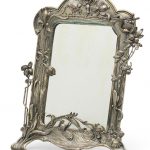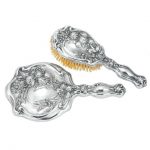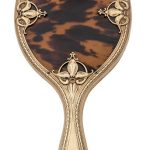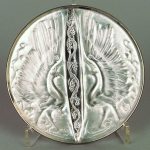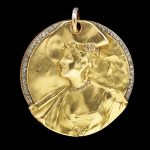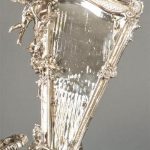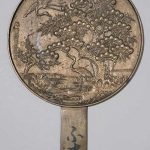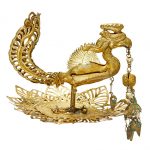Art Nouveau Mirrors. The 19th century ended with Art Nouveau (1890s-1910s), the century’s most popular style, which influenced visual arts and architecture across the western world. Particularly vibrant in the decorative arts, Art Nouveau originated in France, was adapted in Britain with some reserve, but thrived in many versions in the rest of Europe, the USA and beyond. Reference: Museum of Applied Arts and Science.
Below are some examples of Art Nouveau mirrors which can be portable.
An art nouveau silver-plated dressing table mirror The shaped frame decorated with fish, dragonfly, snake and irises, stamped GAB, 33.5cm wide, 2cm deep, 45cm high (13in wide, 0 1/2in deep, 17 1/2in high)
Sold for £ 255 inc. premium at Bonham’s in 2019
Sterling Silver Art Nouveau Hand Mirror and Brush Length of mirror 10 inches.
Sold for $312 (includes buyer’s premium) at Doyle in 2011
An English Art Nouveau 9K Gold and Tortoise Mounted Hand Mirror Charles Henry Dumenil, London, circa 1876 marked with sponsor, 375 Length 10 1/2 inches.
Sold for $1,000 at Hindman in 2019
Art Nouveau hand mirror, ‘Deux Oiseaux’ (two birds), by Lalique Made by Lalique, Rene in Wingen-sur-Moder, Bas-Rhin, Alsace, France, Europe, c 1932. This is a glass and silver-mounted Art Nouveau-style hand mirror, ‘Deux Oiseaux’ (two birds), made by René Lalique et Cie in France in about 1925. René Lalique was one of France’s foremost Art Nouveau jewellery and glass designers. His designs featured Art Nouveau motifs such as dragon flies, sinuous female figures and plants. He set up his factory at Combs-la-Ville in 1909 and another at Wingen-sur-Moder in 1921 to mass produce high-quality glassware to his imaginative designs.
Reference: Museum of Applied Art and Sciences
Locket/ pendant of gold set with diamonds. The front of the locket features the head and shoulders of a woman. Within is a mirror.
The human form, minutely sculpted in gold, was an important theme in Art Nouveau jewellery. Personifications of idealised female beauty were particularly popular. Here the figure conveys a windswept and carefree elegance. The relief is the work of Georges van der Straeten, a sculptor who was born in Ghent in 1856 and who worked mainly in Paris until his death in 1928. Mounted as a locket (which contains a mirror) it is inscribed on the reverse ‘Monte Carlo 13 March 1901’ around a sprig of mistletoe.
Reference: © Victoria and Albert Museum
Art Nouveau table mirror, in silvered metal. France (1900). With decoration in relief, rocaille and reticulate motifs of cupid, birds and female bust. . Measurements: 54 x 31 cm
Sold for €500 at Subastas Segre in 2019
